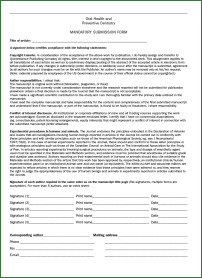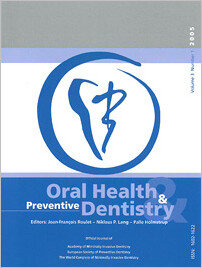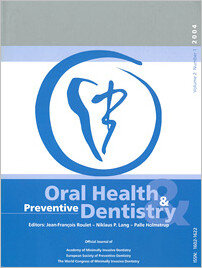DOI: 10.3290/j.ohpd.a10824Pages 203-207, Language: EnglishHenriksen, Birgitte M./Engedal, Knut/Axéll, TonyDOI: 10.3290/j.ohpd.a10818Pages 209-215, Language: EnglishBasak, Cinar Ayse / Nilufer, Kosku / Murtomaa, HeikkiObjective: To assess the association between toothbrushing and dietary self-efficacy and oral health status and behaviour related to it among Turkish pre-adolescents.
Materials and Methods: A cross-sectional study of Turkish school pre-adolescents aged 10 to 12 (n = 611) by oral health examinations (OHE) and self-administered health behaviour questionnaire (PHBQ). The PHBQ, including new Toothbrushing (TBSES), and modified Dietary Self-Efficacy (DSES), was designed to survey pre-adolescents' oral, dietary and general hygiene behaviour by psychosocial factors. An OHE based on World Health Organization criteria was implemented. The participation rate was 97% (n = 591), and 95% (n = 584) for PHBQ and OHE. Multiple linear regression analysis, descriptive statistics, factor and item analysis, Pearson correlation coefficient, chi-square test, and Student t-test were applied.
Results: Pre-adolescents, mostly with regular toothbrushing habits (69% at least once a day) and high levels of irregular dental visits (79%) had as their mean DMFS figure 3.77 ± 3.37. Principal component analysis for TBSES and DSES revealed that four factors met the Kaiser Criteria, accounting for 50.2% of total variance. Scales with good internal consistency and test-retest stability were associated with professionally (DMFS) and self-assessed dental health (p 0.05). A similar tendency appeared between self-assessed gingival health and DSES (p 0.05).
Conclusion: Self-efficacy beliefs were associated with oral health and related behaviour among pre-adolescents. Further research is needed for implementation of scales to enhance oral health.
Keywords: pre-adolescents, oral health, self-efficacy, Turkey
DOI: 10.3290/j.ohpd.a10821Pages 217-224, Language: EnglishTraebert, Eliane S. A. / Peres, Marco A.Purpose: To evaluate the prevalence and the impact of malocclusions on the quality of life of 18-year-old young male adults.
Materials and Methods: Cross-sectional study involving young adults who applied for military service in the city of Florianópolis in the year 2003 (N = 3735). The sample size was 414 individuals randomly selected during the health examination days. The malocclusion data were obtained through the Dental Aesthetic Index variables. The impact of the oral health conditions on the quality of life was obtained through the Oral Impact on Daily Performance.
Results: The highest prevalence was the molar relationship in mesio- or disto-occlusion with 57.3% (95%CI 52.5 - 62.1); 36.4% (95%CI 28.6% - 4.2%) of the applicants reported an impact on their quality of life as a result of the oral health condition. Results from the multiple logistic regression analysis showed that only the incisal crowding [OR 1.9 (95%CI 1.2 - 3.1)] (p = 0.008) showed an impact on the applicants' quality of life.
Conclusion: The malocclusion of highest prevalence was molar relationship disorders (57.3%), and only the dental crowding generated an impact on the quality of life.
Keywords: malocclusions, epidemiology, self-perception, impact, young adults
DOI: 10.3290/j.ohpd.a10823Pages 225-235, Language: EnglishWidström, Eeva / Ekman, Agneta / Aandahl, Liljan S. / Pedersen, Maria Malling / Agustsdottir, Helga / Eaton, Kenneth A.Purpose: There is a number of systems for the provision of oral health care, one of which is the Nordic model of centrally planned oral health care provision. This model has historically been firmly based on the concept of a welfare state in which there is universal entitlement to services and mutual responsibility and agreement to financing them. This study reports and analyses oral health care provision systems and developments in oral health policy in the Nordic countries (Denmark, Finland, Iceland, Norway and Sweden) since 1990.
Material and Methods: Descriptions of and data on the oral health care provision systems in the Nordic countries were obtained from the Chief Dental Officers of the five countries, and contemporary scientific literature was appraised using cross-case analyses to identify generalisable features.
Results: It was found that in many respects the system in Iceland did not follow the 'Nordic' pattern. In the other four countries, tax-financed public dental services employing salaried dentists were complemented by publicly subsidised private services. Additional, totally private services were also available to a variable extent. Recently, the availabilty of publicly subsidised oral health care has been extended to cover wider groups of the total population in Finland and Sweden and, to a smaller extent, in Denmark. Concepts from market-driven care models have been introduced. In all five countries, relative to the national populations and other parts of the world, there were high numbers of dentists, dental hygienists and technicians. Access to oral health care services was good and utilisation rates generally high. In spite of anticipated problems with increasing health care costs, more public funds have recently been invested in oral health care in three of the five countries.
Conclusion: The essential principles of the Nordic model for the delivery of community services, including oral health care, i.e. universal availability, high quality, finance through taxation and public provision, were still adhered to in spite of attempts at privatisation during the 1990 s. It appeared that, in general, the populations of the Nordic countries still believed that there was a need for health and oral health care to be paid for from public funds.
Keywords: health policy, Nordic countries, oral health care, public, private, reform
DOI: 10.3290/j.ohpd.a10817Pages 237-241, Language: EnglishAswini, Y. B. / Tangade, Pradeep S. / Ankola, Anil V. / Nagesh, L. / Pradnya, HedgePurpose: Fizzy drinks are known to be erosive or cariogenic, but little is known about the ways of reducing their harmfulness by altering the method of drinking. The purpose of this study was to assess the changes in plaque pH, at different time intervals in vivo after consuming a carbonated beverage (sprite, pH = 2.98) with plastic glass, straw and directly from bottle.
Design: A clinical study.
Material and Methods: Eighteen subjects aged 18-25 years were recruited for the study and were divided randomly into three groups, six in each (group A- plastic glass, B- straw and C- directly from bottle) after the salivary pH was measured. Subjects were requested to refrain from brushing for 24 hours prior to the study. Collection of pooled plaque was done before and after consuming the drink at five, 10-, 20- and 30-minute intervals. Plaque pH was assessed by glass combination electrode. ANOVA and post hoc Tukey's test was used for statistical analysis.
Results: Highest mean pH drop (5.29) was recorded when consumed with plastic glass at all time intervals. There was a significant difference between group A and B at 5 min and 10 min (P 0.05). However, no difference was seen between group B and C, A and C (P > 0.05).
Conclusions: The use of a straw and direct consumption of beverage from the bottle could limit harmful effects on dentition.
Keywords: dental erosion, carbonated beverages, plaque, pH, cariogenic diet
DOI: 10.3290/j.ohpd.a10822Pages 243-248, Language: EnglishTraebert, Jefferson / de Lacerda, Josimari Telino / Fischer, Tatiana Konrad / Jinbo, YasakaPurpose: To estimate the prevalence of dental caries and orofacial pain in 12-year-old schoolchildren in the Southern Brazilian town of Palhoça in 2003 and to compare it with results from 1997.
Materials and Methods: A cross-sectional study was carried out involving 444 randomly selected 12-year-old schoolchildren in 2003. WHO (1997) criteria for dental caries and Locker and Grushka (1987) criteria for orofacial pain were used. Chi-square and Fisher exact tests were used to examine association between variables. To test the independence of variables, logistic regression analysis was performed.
Results: The prevalence of caries was 55.8%. The mean DMF-T was 1.65. Component D was the one that most contributed to the indicator. In 1997, caries prevalence was 73.5% and the mean DMF-T was 2.84. Similarly, the component that most contributed to the indicator was D with 74.0%. In the trend analysis a reduction of 24.1% in the caries prevalence and 41.9% in the severity measured by the DMF-T was observed. The prevalence of orofacial pain was 66.6%. In 1997, the prevalence was 79.5%. In both years the most common type of pain was stimulated toothache. A reduction of 12.9% in the prevalence of orofacial pain and 28.3% in stimulated toothache was observed. Results of the logistic regression analysis showed that orofacial pain was associated with dental caries independently of other studied variables.
Conclusion: A reduction in both caries and orofacial pain in the studied period was observed. Orofacial pain was independently associated with the presence of caries.
Keywords: dental caries, orofacial pain, trends, prevalence
DOI: 10.3290/j.ohpd.a10816Pages 249-261, Language: EnglishAdewakun, Adenike A. / Percival, Tricia M. / Barclay, Sally R. / Amaechi, Bennett T.Purpose: To determine the prevalence, severity and caries burden among children residing in eastern Trinidad.
Materials and Methods: This is a cross-sectional study comprising probability, stratified, and proportionate-to-size sampling. Seven hundred and eleven school children aged six, 12 and 15 years were examined between November 1999 and January 2000 by two calibrated dentists using World Health Organization (WHO) assessment criteria.
Results: Overall mean DMFT and dft scores were 1.29 ± 2.3 and 1.78 ± 3.1 while 30.4% were caries-free. At ages six, 12 and 15 years, mean DMFT scores were 0.08 ± 0.38; 2.18 ± 2.49; 2.66 ± 3.0 while dft scores were 3.74 ± 3.63; 0.14 ± 2.65; 0. Significant Caries Indices (SiC) for permanent and primary teeth were 3.75 and 5.28. Children of parents/carers with university education had the lowest DMFT/dft scores (1.0 ± 2.47/0.83 ± 1.58), treatment need (23.8%), and comprised the highest proportion of caries-free (76.2%) population. The values for father/male carer were statistically significant (p 0.005). All four first permanent molars were decayed in 8.76%. First permanent molars were most frequently decayed in 12-year-olds (55.4%) and 15-year-olds (50.0%). Untreated caries and first permanent molar decay among six-year-olds were 84% and 8.3% respectively. Tooth mortality was 0.978 and 0.964 in permanent and primary teeth. The Restorative Indices for permanent and primary teeth were 0.02134 and 0.0213.
Conclusion: Based on WHO severity criteria for the respective ages, caries experience is low in Eastern Trinidad. The mean DMFT is much lower than recently reported country data for 12-year-olds. However, the incidence is increasing. The SiC suggests that a small proportion of the population accounts for most of the decayed teeth.
Keywords: caries prevalence, caries experience, Significant Caries Index, caries burden
DOI: 10.3290/j.ohpd.a10820Pages 263-272, Language: EnglishBenjasupattananan, Supranee / Lai, Caroline S. Y. / Persson, G. Rutger / Pjetursson, Bjarni E. / Lang, Niklaus P.Objectives: To assess the effects of an experimental 0.454% stannous fluoride (SnF2) dentifrice on the oral sulcular microbiota in patients with various stages of oral diseases using checkerboard DNA-DNA hybridization.
Material and Methods: In the present one-month, single center, single product, prospective cohort trial, 37 adults (mean age 37.6) were assigned to one of four oral health condition cohorts with seven to 10 subjects each: 1. mild gingivitis, 2. marked generalized gingivitis to moderate periodontitis, 3. caries-prone and 4. treated moderate to advanced chronic periodontitis in supportive periodontal care.
All four groups were asked to use the test dentifrice and a power toothbrush twice a day for one minute during a four-week test period. Before and after the trial period, Plaque Indices (PlI, Silness and Löe, 1964) and Gingival Indices (GI, Löe and Silness, 1963) were recorded. Subgingival plaque samples were collected from all patients at Baseline, as well as after two and four weeks. These samples were analyzed for content of 40 bacterial species using checkerboard DNA-DNA hybridization.
Results: As a result of the only one minute brushing with the stannous fluoride dentifrice, the mean PlI at Baseline was significantly lower (p 0.05) from the mean PlI at four weeks. No statistically significant differences were found between premolar and molar mean values. Moreover, no statistically significant differences were found between the mean GI at Baseline and at four weeks. The microbiological analysis showed that at baseline subjects in groups 2 and 4 had significantly higher bacterial loads of bacteria than groups 1, and 3 (i.e. A.actinomyctemcomitans P.gingivalis, T.forsythia, and T.denticola. Over the study period, the total bacterial load did not change in groups 2, 3 and 4. In groups 1 and 3, however, an increase in the loads of Streptococci spp. were noticed (p 0.05) including S.mitis, S.intermedius, and S.sanguis (p 0.01) suggesting an increase in the presence of early colonizing and health associated bacteria.
Conclusion: One minute brushing with a 0.454% stannous fluoride dentifrice did - after four weeks - not affect the subgingival microbial profiles in patients with moderate periodontitis and treated moderate to advanced periodontitis. However, the sulcular microbial profiles of mild gingivitis and caries-prone patients were affected, indicating a shift towards a gingival health associated microbiota in the sulcular region of patients not affected by attachment loss.
Running Head: Effect of stannous fluoride on sulcular microbiota
Keywords: biofilm, dentifrice, DNA-DNA hybridization, gingivitis, periodontitis, stannous fluoride
 The open access journal "Oral Health and Preventive Dentistry" (from the start of 2020) is licensed under a Creative Commons Attribution 4.0 International License.
The open access journal "Oral Health and Preventive Dentistry" (from the start of 2020) is licensed under a Creative Commons Attribution 4.0 International License.













